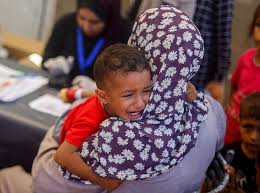WASHINGTON DC (The Hill): The U.S. withdrawal from Afghanistan is over, but congressional oversight has just barely begun.
Lawmakers continue to have lingering questions about a withdrawal that saw the deaths of 13 U.S. troops, as well as scores of Afghans, and are promising hearings and probes in the coming weeks.
Already one House committee has moved to try to compel answers, advancing a defense policy bill this past week that would require reports on everything from the decision to leave Bagram Air Base to what military equipment was left behind.
Here are five questions about the withdrawal lawmakers want answered.
How can those left behind leave?
Perhaps the most immediate question lawmakers have is how the administration plans to help get out Americans and Afghans who did not make it onto U.S. military evacuation flights before they ended.
Despite evacuating roughly 124,000 people, the Biden administration has acknowledged that 100 to 200 Americans who wanted to leave, as well as most Afghans who have applied for Special Immigrant Visas (SIVs) intended for those who helped the U.S. government, are still in Afghanistan.
Administration officials have stressed that while the military operation has ended, overall evacuation efforts have not, saying they will now rely on diplomatic means and that they expect the Taliban to uphold its commitment to let people leave.
But lawmakers in both parties want answers as to how exactly that will work.
Twenty-six GOP senators on Thursday wrote a letter to Biden asking for the exact number of Americans and SIV applicants still in Afghanistan, while a separate letter from 10 Republican senators asked for “answers about how your administration intends to keep its promise to continue assisting individuals who desire to evacuate.”
Sen. Jeanne Shaheen (D-N.H.) also penned a letter to Secretary of State Antony Blinken on Thursday asking for an update on the evacuation status of 2,200 names she provided the department, as well as generally a “better understanding of the process to support those who still remain.”
During its consideration of the National Defense Authorization Act (NDAA), the House Armed Services Committee also adopted some amendments related to the issue, including one from Rep. Jason Crow (D-Colo.) that would require plans to retrieve U.S. citizens and SIV applicants as part of a wide-ranging report on the situation in Afghanistan.
Why was the US caught off-guard?
Despite warnings from lawmakers and advocates to start evacuations almost as soon as President Joe Biden announced the withdrawal in April, as well as reportedly increasingly grim U.S. intelligence assessments about the fate of Kabul, evacuation operations did not begin on a large scale until after Kabul fell to the Taliban in August.
Biden and his closest allies in Congress have insisted that the resulting chaos could not have been avoided and touted the evacuation operations as a success. But other lawmakers still want answers on why the White House appeared to be caught off guard by the rapid collapse of the U.S.-backed government and security forces, as well as the Taliban’s swift reascension to power.
“Now that our airlift operations have concluded and the next phase of evacuation without United States troops on the ground begins, the U.S. Senate Armed Services Committee should quickly begin investigating the rapid collapse of the Afghan government and forces after two decades of American investment of resources and troops, and why we were unable to better anticipate it,” Sen. Tammy Duckworth (D-Ill.) said in a statement after the last U.S. troops departed, blaming “mistakes made by administrations of both parties—as well as Congress—over the last 20 years that made this evacuation necessary in the first place.”
Sen. Deb Fischer (R-Neb.) also pushed Senate Armed Services leaders to hold a hearing with Defense Secretary Lloyd Austin, Chairman of the Joint Chiefs of Staff Gen. Mark Milley, and Director of National Intelligence Avril Haines since Biden has “repeatedly referred to and characterized advice he received from senior military officials, as well as the judgment of the intelligence community,” she wrote in a letter.
One of the House Armed Services Committee’s approved NDAA amendments, offered by Rep. Sara Jacobs (D-Calif.) would require an inspector general investigation into the performance of Afghan forces, including why they proved “unable to defend” their country.
Why did the military leave Bagram?
Some of Biden’s fiercest critics have specifically pointed at the decision to withdraw from Bagram Air Base in July before evacuating any civilians as a major misstep.
Bagram was the U.S. military’s largest base in Afghanistan and has two runways compared to the Kabul airport’s single runway. Opponents argue that keeping Bagram Air Base open could have helped evacuations go smoother and gotten more people out.
U.S. military and administration officials have defended the decision to leave Bagram, saying that staying would have been impractical since evacuees would have had a hard time getting to a base 40 miles outside of the capital, and securing it would also require a large number of troops.
Still, lawmakers want further explanation, with the House Armed Services adopting an National Defense Authorization Act (NDAA) amendment from Rep. Vicky Hartzler (R-Mo.) that would require the Pentagon to brief lawmakers on the “strategic decision” behind leaving Bagram.
What about the weapons seized by the Taliban?
As it left the Kabul airport, the United States military trashed the aircraft, vehicles and other equipment it had to leave behind to render them unusable for the Taliban or other bad actors.
But the Taliban still possesses an unknown number of Black Hawk helicopters, A-29 light attack aircraft, Humvees, small arms and other weapons that the United States had given to the now-defunct Afghan security forces.
Republicans in particular have seized on the pictures and videos circulating on social media of the Taliban with U.S.-made weapons.
Several Republicans have demanded an accounting of all the weapons seized by the Taliban as well as plans to recapture or destroy the equipment, including a letter late last month from Republicans on the House Oversight Committee to Austin blaming the “Biden administration’s poorly planned and executed United States withdrawal from Afghanistan” for the Taliban now being “armed with a significant arsenal of U.S.-made weaponry.”
The House Armed Services Committee also approved an amendment from Rep. Don Bacon (R-Neb.) that would require the Pentagon to report on equipment that was “destroyed, surrendered or abandoned” in Afghanistan.
How will counterterrorism work going forward?
Looking ahead, one of the big questions lawmakers have is about so-called over-the-horizon counterterrorism operations.
One of the main arguments proponents of staying in Afghanistan have used over the last 20 years was the need to prevent it from becoming the terrorist safe haven that it was prior to the U.S. invasion.
The Biden administration has argued it can accomplish that goal with drone strikes and other military assets based outside of Afghanistan, pointing to two recent over-the-horizon strikes against ISIS-K targets as proof it can be done.
But with no basing agreements with Afghanistan’s neighbors, a higher degree of difficulty for intelligence collection with no forces on the ground, and reports of civilian casualties from at least one of the ISIS-K strikes, questions persist.
The report required in Crow’s National Defense Authorization Act amendment would also have to detail plans and capabilities for over-the-horizon forces.
A separate amendment the House Armed Services Committee approved from Rep. Mike Rogers (R-Ala.), the panel’s ranking member, would also require the Pentagon to give lawmakers a plan for counterterrorism operations going forward, with the text of the measure saying the committee is “particularly concerned that it has not been presented with clearly defined plans to conduct counterterrorism operations and respond to terrorist threats emanating from Afghanistan.”






